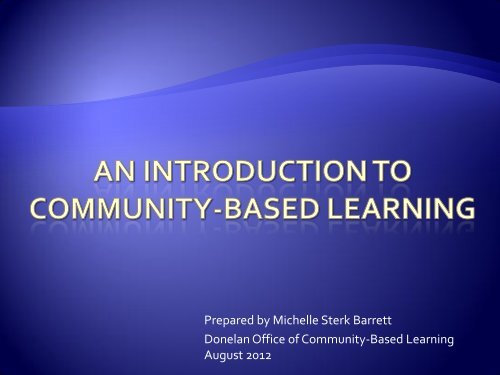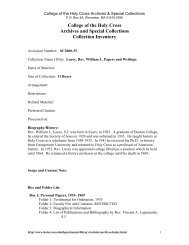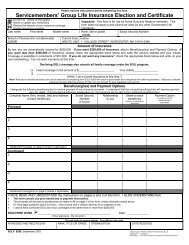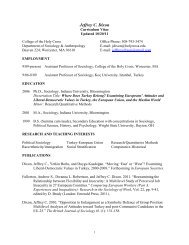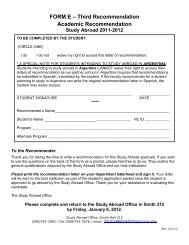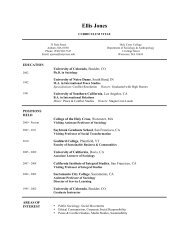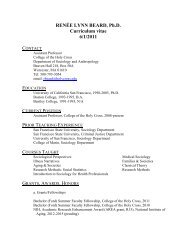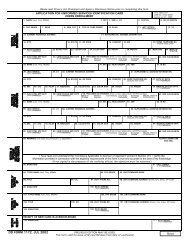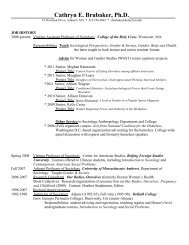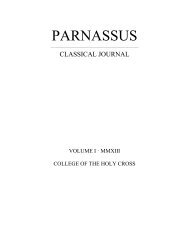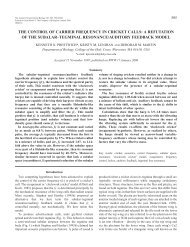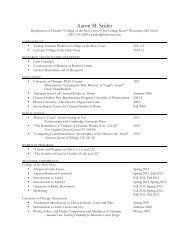An Introduction to Community-based learning - Academics
An Introduction to Community-based learning - Academics
An Introduction to Community-based learning - Academics
Create successful ePaper yourself
Turn your PDF publications into a flip-book with our unique Google optimized e-Paper software.
Prepared by Michelle Sterk Barrett<br />
Donelan Office of <strong>Community</strong>-Based Learning<br />
August 2012
Nationally, there is wide variation in how the term CBL is used. Some<br />
institutions may include anything that involves off-campus, academic <strong>learning</strong><br />
under the umbrella of CBL. Others define CBL more narrowly <strong>to</strong> include only<br />
service <strong>learning</strong> activities.<br />
CBL and service <strong>learning</strong> are often considered interchangeable in professional<br />
and academic writing. Service <strong>learning</strong> is the term used more frequently in<br />
widely-cited research studies because it pre-dates the existence of the term<br />
CBL. Please keep this in mind while reading study results presented in this<br />
Power Point.<br />
At Holy Cross, CBL has been implemented primarily in a manner synonymous<br />
with SL, but has also included some community <strong>based</strong> research, internships,<br />
practica, field work, etc.<br />
Jesuit schools more frequently use the language of “service <strong>learning</strong>.”<br />
Many of our non-Jesuit peer institutions (i.e., Amherst, Bates, Bowdoin,<br />
Oberlin, Smith, Mt. Holyoke) use the term CBL .
CBL at Holy Cross is defined in the<br />
following manner:<br />
<strong>Community</strong>-<strong>based</strong> <strong>learning</strong> (CBL) is a teaching approach that connects<br />
classroom <strong>learning</strong> objectives with civic engagement. Civic<br />
engagement occurs through service that meets community-identified<br />
needs or through research and experience that holds promise of social<br />
or scientific value <strong>to</strong> the community. In this mutually beneficial<br />
process, students are able <strong>to</strong> gain a deeper understanding of course<br />
content by integrating theory with practice, while communities gain<br />
access <strong>to</strong> volunteers, resources, and the wide-ranging research and<br />
scholarly expertise housed in the College's many disciplinary<br />
departments.<br />
Consistent with the Holy Cross tradition of preparing students for a<br />
lifetime of <strong>learning</strong> and moral citizenship, CBL students at Holy Cross<br />
are invited <strong>to</strong> reflect upon moral and ethical questions of social<br />
responsibility while considering how <strong>to</strong> live purposefully in a manner<br />
that enables one’s unique gifts <strong>to</strong> positively contribute <strong>to</strong> society.
Themes incorporated in<strong>to</strong> the Holy Cross definition:<br />
Integration of theory with practice<br />
Pedagogical strategy<br />
Reciprocal partnerships that simultaneously meet<br />
community needs and course <strong>learning</strong> goals<br />
Critical reflection<br />
Includes service, community-<strong>based</strong> research, and<br />
experiences of potential value <strong>to</strong> the community<br />
Language consistent with widely-adopted best practices
<strong>Community</strong> service is not explicitly or formally linked <strong>to</strong> academics.<br />
<strong>Community</strong> service does not typically emphasize integration of theory and<br />
practice.<br />
<strong>Community</strong> service is not a pedagogical strategy.<br />
<strong>Community</strong> service does not usually emphasize reciprocity in partnerships<br />
(Focus is on needs of the service site not the <strong>learning</strong> goals of the student).<br />
Critical Reflection may or may not occur after service experience.<br />
However, service experiences that include reflection and <strong>learning</strong> goals<br />
(even if outside a classroom) are sometimes legitimately named “service<br />
<strong>learning</strong>.”<br />
COMMON MISCONCEPTION:<br />
CBL class = a class + some community service
The activities of CBL and other field-<strong>based</strong> <strong>learning</strong><br />
experiences can be identical--especially if they are in a nonprofit<br />
or governmental setting.<br />
All forms of experiential education use a pedagogical<br />
strategy that combines experience with <strong>learning</strong> goals.<br />
All forms of experiential education have the potential <strong>to</strong> be of<br />
mutual benefit <strong>to</strong> students and communities.<br />
The difference is the emphasis:<br />
The <strong>learning</strong> goals of CBL are focused on academic content<br />
and civic engagement, not professional development.<br />
Reflection activities are emphasized as a central means <strong>to</strong><br />
achieve <strong>learning</strong> goals in CBL.<br />
The reciprocal nature of the partnerships is central <strong>to</strong> CBL.
Field work,<br />
Practica,<br />
Experiential<br />
Clinicals<br />
Education<br />
Labora<strong>to</strong>ry<br />
Experience<br />
<strong>Community</strong>-<br />
Based<br />
Learning<br />
Internships<br />
<strong>Community</strong><br />
Service
1966: Term “service-<strong>learning</strong>” used <strong>to</strong> describe a project linking Tennessee<br />
universities with community development organizations<br />
1970: Bos<strong>to</strong>n College’s PULSE Program founded<br />
1985: Campus Compact founded by presidents of Brown, George<strong>to</strong>wn,<br />
Stanford, and the Education Commission of the States <strong>to</strong> promote and<br />
support campus-<strong>based</strong> civic engagement efforts<br />
1989: Wingspread Principles of Good Practice in Service Learning written<br />
(further refined by Dr. Jeff Howard in 1993 and 2001)<br />
1993: Learn & Serve America is created as part of the Corporation for<br />
National & <strong>Community</strong> Service. Leads <strong>to</strong> widespread establishment of<br />
campus service <strong>learning</strong> offices/centers
1994: The Michigan Journal of <strong>Community</strong> Service Learning<br />
founded<br />
1997: Campus Compact VISTA program established<br />
2001: First international conference on service <strong>learning</strong><br />
2001: Donelan Office of CBL established at Holy Cross<br />
2005: The International Association for Research on Service-<br />
Learning and <strong>Community</strong> Engagement (IARSLCE) founded<br />
Late 1990s-present: New terms and concepts begin <strong>to</strong><br />
emerge in addition <strong>to</strong> service <strong>learning</strong> (e.g., community-<strong>based</strong><br />
<strong>learning</strong>, community engagement, civic engagement, education for<br />
active citizenship)<br />
Campus Compact now includes 1,200 members
It’s more work with no additional compensation.<br />
There’s risk associated with loss of control.<br />
Lack of confidence in utilizing a new pedagogy<br />
Uncertainty about how <strong>to</strong> integrate in<strong>to</strong> course<br />
Taking time away from covering course content<br />
Fear that it could negatively impact tenure<br />
because of time away from research and/or<br />
negative impact on course evaluations.
The Donelan Office exists <strong>to</strong> minimize these challenges as<br />
much as possible by:<br />
Supporting you so you can build confidence with the<br />
method<br />
Minimizing time involved with developing and conducting<br />
a CBL course by gathering resources, conducting<br />
workshops and one-on-one consulting, providing sample<br />
syllabi in a variety of disciplines, connecting your students<br />
with high quality community partnerships, and providing<br />
CBL Scholars <strong>to</strong> support you and facilitate reflection<br />
sessions.<br />
Theory and research support the notion that it is worth<br />
overcoming the barriers because of the benefits <strong>to</strong> students,<br />
communities, and classroom <strong>learning</strong> environments.
The courage <strong>to</strong> take pedagogical risks is often<br />
looked upon favorably in the tenure process at<br />
Holy Cross.<br />
“The College respects faculty members who seek <strong>to</strong> engage their students<br />
in ways that are new and exciting and challenging—<strong>to</strong> them (the faculty)<br />
as well as <strong>to</strong> the students! This is true whether the innovation involves the<br />
use of "clickers" in a physics lecture, the introduction of live chat sessions with<br />
students at a Russian university via Skype, an opportunity <strong>to</strong> mount their<br />
own exhibition at the Worcester Art Museum, ... or a community-<strong>based</strong><br />
<strong>learning</strong> activity When a new initiative does not go well -- and all<br />
challenging initiatives must be capable of missing their targets -- this<br />
may result in the need <strong>to</strong> talk about the whole experience as part of<br />
mounting one's "case" for tenure. What was one trying <strong>to</strong> do? What did<br />
one learn about CBL and its nuances? What would one do differently next<br />
time? But this is all a chance <strong>to</strong> demonstrate one's commitment <strong>to</strong><br />
teaching and one's self-awareness as a teacher. That is basically all<br />
good.” -Dean Timothy Austin<br />
The Holy Cross mission and student interest<br />
are consistent with CBL.
Based upon research, George Kuh, the developer<br />
of the National Survey for Student Engagement<br />
(NSSE), consistently promotes CBL/service<br />
<strong>learning</strong> as among the highest impact<br />
educational practices on student engagement<br />
and student success.<br />
Theories from Kolb, Sanford, student<br />
development, and Ibarra help explain why.
David Kolb’s (1981) Learning Model suggests that effective <strong>learning</strong><br />
takes place when students are able <strong>to</strong> complete a cycle of concrete<br />
experience, reflective observation, abstract conceptualization, and<br />
active experimentation as illustrated below. Traditional courses<br />
focus solely on the abstract conceptualization (theorizing) aspect<br />
of the model without placing the theory within context. Thus,<br />
traditional courses prevent the possibility for students <strong>to</strong> learn<br />
from experience and apply theory <strong>to</strong> experience.<br />
“Immediate concrete [affective] experience is the basis for<br />
observations and reflection. <strong>An</strong> individual uses these observations<br />
<strong>to</strong> build an idea, generalization or ‘theory’ from which new<br />
implications for action can be deduced. The implications or<br />
hypotheses then serve as guides in acting <strong>to</strong> create new<br />
experiences” (Kolb, 1981, p. 235).<br />
(Graphic rrom http://www.ldu.leeds.ac.uk/ldu/sddu_multimedia/kolb/static_version.php)
Love and Guthrie (1999) argue that each of the major<br />
cognitive development theories (Baxter Magdola,<br />
Belenky et al, King & Kitchener, and Perry) includes what<br />
they label the “Great Accommodation.” This is the point<br />
of largest change in cognitive development and occurs<br />
when an individual transitions from viewing the world as<br />
comprehensible <strong>to</strong> seeing the world as complex and<br />
unknowable.<br />
Major student development theories (Chickering and<br />
Reisser, 1993; Sanford, 1962) also point <strong>to</strong>ward the role<br />
that encountering difference and facing disequilibrium<br />
can play in facilitating significant personal development<br />
for undergraduates.<br />
Sanford discusses the need for a proper balance<br />
between challenge and support for healthy development<br />
<strong>to</strong> occur (this concept will be further developed later).
Ibarra (2001) argues that, depending upon cultural<br />
background and gender, students have varying needs of<br />
context and collaboration for effective <strong>learning</strong> <strong>to</strong> occur.<br />
“Dewey was aware that the intellect cannot be separated<br />
from the heart…<strong>learning</strong> needs <strong>to</strong> be “wholehearted,” tying<br />
feeling <strong>to</strong> intellect…caring leads <strong>to</strong> the need <strong>to</strong> know” (Eyler<br />
& Giles, 1999, p. 84).<br />
Thus, according <strong>to</strong> theory, CBL is a high impact practice<br />
because it:<br />
Enables students <strong>to</strong> learn in a variety of modalities<br />
Enables the possibility for cognitive<br />
dissonance/disequilibrium <strong>to</strong> occur in a setting where<br />
students can receive support from faculty, peers, and<br />
course content<br />
Resonates with the <strong>learning</strong> style of students from a<br />
variety of cultural backgrounds
In 2001, researchers at Vanderbilt University (Eyler,<br />
Giles, Stenson, & Gray) conducted a thorough<br />
literature review <strong>to</strong> summarize the findings from<br />
CBL/service <strong>learning</strong> research. Studies have<br />
consistently found CBL/service <strong>learning</strong> positively<br />
impacts or has a positive relationship <strong>to</strong>:<br />
Academic <strong>learning</strong> as reported by students and<br />
faculty<br />
Academic outcomes such as complexity of<br />
understanding, problem analysis, critical thinking,<br />
and cognitive development.<br />
Students’ ability <strong>to</strong> apply what they have learned<br />
in the “real world”
Personal development such as sense of personal<br />
efficacy, personal identity, spiritual growth, and<br />
moral development<br />
Interpersonal development and communication<br />
skills<br />
Reducing stereotypes and facilitating cultural and<br />
racial understanding<br />
Sense of social responsibility and citizenship skills<br />
Likelihood of graduating<br />
Career development<br />
Relationships with faculty and satisfaction with the<br />
college/university
“Learning begins with curiosity, with wanting <strong>to</strong><br />
know. As we saw in our survey…students often<br />
find the link between <strong>learning</strong> and doing <strong>to</strong> be a<br />
powerful source of motivation and they<br />
recognize the role of service [community<br />
engagement] in producing a passion <strong>to</strong> learn<br />
more…this passion for the experience also spills<br />
over in<strong>to</strong> the classroom, producing higher levels<br />
of engagement in the subject.” (Eyler & Giles,<br />
1999, p. 85).
In 2000, Fr. Kolvenbach, the Superior General of the Society of Jesus,<br />
outlined a vision for Jesuit higher education stating,<br />
“Our universities also boast a splendid variety of in-service programs,<br />
outreach programs, insertion programs, off-campus contacts, and hands -on<br />
courses. These should not be <strong>to</strong>o optional or peripheral, but at the core of<br />
every Jesuit university’s program of studies…. Every discipline, beyond its<br />
necessary specialization, must engage with human society, human life, and<br />
the environment in appropriate ways, cultivating moral concern about how<br />
people ought <strong>to</strong> live <strong>to</strong>gether.”<br />
“We must .. ‘educate the whole person of solidarity for the real world.’<br />
Solidarity is learned through ‘contact’ rather than through ‘concepts,’ …<br />
When the heart is <strong>to</strong>uched by direct experience, the mind may be challenged<br />
<strong>to</strong> change. Personal involvement with innocent suffering, with the injustice<br />
others suffer, is the catalyst for solidarity which then gives rise <strong>to</strong> intellectual<br />
inquiry and moral reflection. Students, in the course of their formation, must<br />
let the gritty reality of this world in<strong>to</strong> their lives, so they can learn <strong>to</strong> feel it,<br />
think about it critically, respond <strong>to</strong> its suffering and engage it constructively.”
Excerpts from the Holy Cross mission statement , “To<br />
participate in the life of Holy Cross is <strong>to</strong> accept an<br />
invitation <strong>to</strong> join in dialogue about basic human<br />
questions: …What are our obligations <strong>to</strong> one another?<br />
What is our special responsibility <strong>to</strong> the world's poor and<br />
powerless?…lead all its members <strong>to</strong> make the best of<br />
their own talents, <strong>to</strong> work <strong>to</strong>gether, <strong>to</strong> be sensitive <strong>to</strong><br />
one another, <strong>to</strong> serve others, and <strong>to</strong> seek justice within<br />
and beyond the Holy Cross community.”<br />
Our students demonstrate an exceptional commitment<br />
<strong>to</strong> service. Crawford Sullivan, Bryant Ludden, &<br />
Single<strong>to</strong>n (forthcoming) report that 96% of the Holy<br />
Cross seniors in their study had volunteered in college<br />
(including social service <strong>to</strong> the surrounding community,<br />
religious service, social justice programs, and service <strong>to</strong><br />
the campus) . This compares with a national average of<br />
60% reported by NSSE.
Consistent with student interest, the mission of<br />
Holy Cross, and the vision of Jesuit higher<br />
education outlined by Fr. Kolvenbach, CBL offers<br />
students the possibility <strong>to</strong> engage in the “gritty<br />
reality of the world” in order <strong>to</strong> meaningfully<br />
reflect upon the question of what responsibility<br />
each of us has <strong>to</strong>wards creating a more just<br />
society and how each of us can use our individual<br />
gifts and talents <strong>to</strong> contribute <strong>to</strong>ward this aim.
Sanford (1962; 1967; 1968) proposed that as a result of facing<br />
challenging stimuli, one seeks <strong>to</strong> reduce the tension associated with<br />
disequilibrium by using coping strategies and responses that have<br />
been successful in the past. However, some stimuli are so challenging<br />
that prior strategies and responses are ineffective. Because former<br />
modes of response will not suffice in the face of this new challenging<br />
stimulus, the person is required <strong>to</strong> innovate and respond in a new<br />
manner. It is in this innovative process of developing a new response<br />
that Sanford argues the possibility for growth occurs.<br />
Sanford also argues that it is necessary <strong>to</strong> balance challenge and<br />
support throughout this difficult process of development. Too much<br />
challenge can hinder the possibility for growth because: a) a student<br />
may react defensively and resist change or b) a student may face such<br />
excessive strain that it leads <strong>to</strong> mental health problems (Sanford,<br />
1966, p. 45). To counter these possibilities, Sanford believes it is crucial<br />
<strong>to</strong> offer a student the appropriate level of support when challenges<br />
become overwhelming.
Thus, according <strong>to</strong> Sanford, optimal student<br />
development occurs when there is an<br />
appropriate mix of challenge and support. That<br />
is, as a student faces cognitive dissonance<br />
resulting from exposure <strong>to</strong> challenging stimuli, it<br />
is important <strong>to</strong> support the student in the<br />
process of assimilating new ways of thinking.<br />
Without enough challenge, students do not have<br />
the impetus <strong>to</strong> grow. Without enough support,<br />
students won’t be able <strong>to</strong> effectively move<br />
through the difficult process of growth.
CBL offers the possibility for cognitive dissonance/disequilibrium <strong>to</strong><br />
occur in a manner that can stimulate growth as outlined by Sanford<br />
(as well as other developmental theorists) through:<br />
Exposure <strong>to</strong> diverse perspectives/experiences that do not fit<br />
with prior perspectives/experiences.<br />
Learning that social problems are more complex than they<br />
might have previously appeared and that there are no easy<br />
solutions <strong>to</strong> these problems (aka the “Great Accommodation”)<br />
Relationships built with those experiencing unfair human<br />
suffering at the placement site.<br />
Being asked <strong>to</strong> reflect critically in a manner that pushes<br />
“students <strong>to</strong> explore the assumptions that underlie their own<br />
perceptions and the way that society is organized” (Eyler &<br />
Giles, 1999, p. 198).
Research has found that community-<strong>based</strong><br />
<strong>learning</strong> is a more effective pedagogy (in terms<br />
of achieving desired student developmental<br />
outcomes) when students are engaged in the<br />
community for more than 15-20 hours<br />
throughout the duration of the course (Mabry,<br />
1998; Gray et al., 1998, 1999). This is likely<br />
related <strong>to</strong> the possibility for challenge <strong>to</strong> occur.
Numerous studies have found that supportive relationships play a key<br />
role in high quality community-<strong>based</strong> <strong>learning</strong> experiences (Astin et<br />
al., 2000; Eyler & Giles, 1999; Hatcher et al. , 2004 ; Kiely, 2005;<br />
Radecke, 2007) .<br />
Caring relationships with faculty, peers, and/or those at community<br />
sites can be a significant source of support as students face challenges<br />
associated with CBL.<br />
Astin et al. (2000) conducted a comprehensive investigation of how<br />
service <strong>learning</strong> affects students by collecting longitudinal data from<br />
22,236 undergraduates. The researchers found that discussing service<br />
with peers and “emotional” faculty support “account for more of the<br />
effects of service on the dependent measures than do other mediating<br />
activities….What is particularly interesting is that it is discussion with<br />
other students that most strongly mediates the effect of service on<br />
these outcomes. In other words, the opportunity <strong>to</strong> “process” the<br />
service experience with other students appears <strong>to</strong> be a powerful<br />
component of both community service and service <strong>learning</strong> (p. 33).
The application of the community engagement experience <strong>to</strong><br />
course material can serve as a form of support in that it provides<br />
frameworks through which students can process and make<br />
sense of what they are experiencing in CBL. Course material can<br />
provide insights that help students construct new ways of<br />
knowing.<br />
Additionally, studies have found that applying community<br />
experiences <strong>to</strong> course content is key <strong>to</strong> achieving desired<br />
<strong>learning</strong> and developmental outcomes (Astin, et al., 2000; Eyler<br />
et al., 2001; Eyler & Giles, 1999; Fenzel & Peyrot, 2005 )
Reflection is a means through which relationships can be built, application of<br />
community experience <strong>to</strong> course material can occur, and through which<br />
students can process the challenges they are facing.<br />
Eyler (2002) believes that reflection on the community-<strong>based</strong> <strong>learning</strong><br />
experience is “the process by which individuals develop the capacity <strong>to</strong><br />
understand and resolve complexity” (p. 522) and that there needs <strong>to</strong> be<br />
continual opportunities for student observations <strong>to</strong> be “processed,<br />
challenged, and connected with other information” (p. 526).<br />
Reflection takes many forms with the most prominent being discussions with<br />
other students, discussions with faculty, journal writing, and reflective papers<br />
(Gray et al., 1998).<br />
The quality of reflection in CBL can vary tremendously and the quality level<br />
can have an impact on the student development that occurs (Ash & Clay<strong>to</strong>n,<br />
2004; Eyler & Giles, 1999; Eyler, 2002; Gray et al., 1998; Hatcher & Bringle,<br />
1997; Hatcher et al., 2004).
Eyler, Giles, and Schmiede’s (1996) “4 C’s” of Reflection:<br />
Continuous: reflection activities are undertaken throughout the CBL<br />
course, rather than intermittently.<br />
Connected: reflection efforts are structured and directly related <strong>to</strong> the<br />
<strong>learning</strong> objectives.<br />
Challenging: reflection efforts set high expectations, demand high<br />
quality student effort, and facilitate instruc<strong>to</strong>r feedback that<br />
stimulates further student <strong>learning</strong>.<br />
Contextualized: reflection activities are appropriate <strong>to</strong> the particular<br />
course, and commensurate with and complementary <strong>to</strong> the level and<br />
type of other course <strong>learning</strong> activities (cited in Howard, 2001, p. 20).<br />
Hatcher and Bringle (1997) suggest that reflection should:<br />
Link CBL experiences <strong>to</strong> course <strong>learning</strong> objectives through journals,<br />
directed writing, and class discussions;<br />
Have guidance that includes clear expectations and criteria for<br />
evaluation;<br />
Occur at least once a week<br />
Include feedback and assessment of student understanding of how<br />
course material connects <strong>to</strong> service;<br />
Include the opportunity for students <strong>to</strong> clarify values in light of service<br />
experiences.
Principle 1: Academic credit is for <strong>learning</strong>, not<br />
for service.<br />
Principle 2: Do not compromise academic rigor.<br />
Principle 3: Establish <strong>learning</strong> objectives.<br />
Principle 4: Establish criteria for the selection<br />
of community service placements.
Principle 5: Provide educationally-sound <strong>learning</strong><br />
strategies <strong>to</strong> harvest community <strong>learning</strong> and realize<br />
course <strong>learning</strong> objectives.<br />
“To make certain that service does not underachieve in its role as an<br />
instrument of <strong>learning</strong>, careful thought must be given <strong>to</strong> <strong>learning</strong><br />
activities that encourage the integration of experiential and<br />
academic <strong>learning</strong>. These activities include classroom discussions,<br />
presentations, and journal and paper assignments that support<br />
analysis of service experiences in the context of the course academic<br />
and civic <strong>learning</strong> objectives. Of course, clarity about course <strong>learning</strong><br />
objectives is a prerequisite for identifying educationally-sound<br />
<strong>learning</strong> strategies” (Howard, 2001, p. 17).<br />
Principle 6: Prepare students for <strong>learning</strong> from the<br />
community.<br />
For example, instruction on participant-observation skills or<br />
distribution of prior student written work as models of observation.
Principle 7: Minimize the distinction between the<br />
student’s community <strong>learning</strong> role and the classroom<br />
<strong>learning</strong> role.<br />
Principle 8: Rethink the faculty instructional role.<br />
Faculty member as facilita<strong>to</strong>r and coach rather than<br />
dissemina<strong>to</strong>r of information<br />
Principle 9: Be prepared for variation in, and some loss<br />
of control with, student <strong>learning</strong> outcomes.<br />
Principle 10: Maximize the community responsibility<br />
orientation of the course.<br />
Encourage a communal rather than individual <strong>learning</strong><br />
orientation <strong>to</strong> build commitment <strong>to</strong> community and civic duty.<br />
“Designing classroom norms and <strong>learning</strong> strategies that not<br />
only enhance academic <strong>learning</strong> but also encourage civic<br />
<strong>learning</strong>” (Howard, 2001, p. 19).
Art, CSU Monterey Bay<br />
Large-Scale Digital Mural<br />
“In this course students research public art, collect images,<br />
relevant readings and materials pertaining <strong>to</strong> public art in the<br />
community <strong>to</strong> assist them as they develop a digital mural/public<br />
art project….After completing several digital images students<br />
create one large final, digital work that seeks <strong>to</strong> inform the<br />
public about a relevant issue or community concern (Heffernan,<br />
2001, p. 89).<br />
Environmental Science, CSU Monterey Bay,<br />
Watershed Res<strong>to</strong>ration in the Schools and <strong>Community</strong><br />
“This course asks students <strong>to</strong> share the relevance and<br />
importance of their environmental science knowledge.<br />
Assignments involve implementing projects or teaching courserelated<br />
<strong>to</strong>pics at local schools: landscaping a native plant<br />
garden, designing a nature trail, or coordinating an Earth Day<br />
event” (Heffernan, 2001, p. 86).
Computer Science, San Francisco State University<br />
Web Site Design and Management<br />
“Students design and build fully functioning websites for<br />
a non-profit organization” (Heffernan, 2001, p. 95).<br />
Political Science, Syracuse University<br />
Practicum in Public Policy<br />
“Students work in a government or non-profit<br />
organization in an effort <strong>to</strong> gain an understanding of<br />
public policy processes as they relate <strong>to</strong> the government<br />
and non-profit sec<strong>to</strong>r….Students complete an agency<br />
mission paper in which students comment on their<br />
agency’s mission and purpose, goals, activities, funding<br />
and sources and its “cus<strong>to</strong>mers”—and a final project, in<br />
which the student identifies an area of financial need<br />
and develops a lobbying strategy <strong>to</strong> access funds from<br />
state or local government.
Biology, Kapiolani <strong>Community</strong> College,<br />
Microbiology<br />
“You may receive credit for performing a community service project that<br />
reinforces and applies some of the principles of microbiology you are<br />
<strong>learning</strong> in this course... Suitable service <strong>learning</strong> projects can be chosen<br />
by first discussing your interests and ideas with me or by discussing your<br />
interests with the counselors at the Service Learning Office and looking<br />
over their listing of placement opportunities. HIV/AIDS prevention and<br />
education as well support for people infected with HIV and opportunistic<br />
pathogens are obvious areas of service for students in this class and there<br />
are several opportunities available with agencies that work in these<br />
areas. There are also teaching and tu<strong>to</strong>ring opportunities for high school<br />
and intermediate school students about infectious disease and HIV as well<br />
as other aspects of microbiology.” Retrieved from<br />
http://www.compact.org/syllabi/biology/microbiology-130/4167/<br />
Economics, Lehigh University<br />
Regional Economic Development Practicum<br />
“Student responsibilities include documenting the extent <strong>to</strong> which women<br />
living in the inner city of Allen<strong>to</strong>wn are limited in their search for<br />
employment by the current configuration of bus routes. The study team<br />
meets with LANTA planners <strong>to</strong> identify the ways in which routes could be<br />
changed or new services developed <strong>to</strong> enhance the possibility of<br />
successful transitions from welfare <strong>to</strong> work” (Heffernan, 2001, p. 97).
English/Philosophy, Bos<strong>to</strong>n College<br />
Telling Truths II: Depth Writing as Service<br />
This class “will enable students <strong>to</strong> produce a portfolio of writings<br />
that engage a serious social concern... Students early on will<br />
identify an issue they wish <strong>to</strong> pursue in depth through the course<br />
of the semester. At the same time, they will select a genre they<br />
want <strong>to</strong> develop and <strong>to</strong> work in: non-fiction, fiction, journalism<br />
or poetry. (Students may expand on an issue that has affected<br />
them personally, or one which they have observed in service<br />
work).” Retrieved from:<br />
http://www.bc.edu/content/bc/schools/cas/pulse/courses.html
Avila-Linn, C., Rice, K., & Akin, S. ( 2012). Designing community-<strong>based</strong> courses. Berkeley,<br />
CA: Cal Corps Public Service Center. Retrieved from<br />
http://publicservice.berkeley.edu/faculty/handbook<br />
This resource includes sections on : engaged public scholarship, building campuscommunity<br />
partnerships, developing engaged scholarship courses, supporting student<br />
engagement with the community, deepening the <strong>learning</strong> with reflection, and<br />
developing evaluation and assessment for engaged scholarship.<br />
Campus Compact. ( 2000). <strong>Introduction</strong> <strong>to</strong> service-<strong>learning</strong> <strong>to</strong>olkit: Readings and resources<br />
for faculty. Providence, RI: Campus Compact.<br />
This <strong>to</strong>olkit, available in the Donelan Office, includes articles about: definitions and<br />
principles, theory, pedagogy, community partnerships, reflection, academic culture,<br />
student development, assessment, model programs, redesigning curriculum,<br />
promotion & tenure, and recommended resources.<br />
Campus Compact<br />
The Campus Compact website includes a number of useful links for CBL course<br />
development at: http://www.compact.org/category/resources/service-<strong>learning</strong>resources/
Howard, J. (2001, Summer). Service-<strong>learning</strong> course design workbook.<br />
Michigan Journal of <strong>Community</strong> Service Learning Companion Volume.<br />
This workbook, available in the Donelan Office, includes sections on:<br />
clarifying the conceptualization, foundational resources, relevant and<br />
meaningful service with the community, enhanced academic <strong>learning</strong>,<br />
purposeful civic <strong>learning</strong>, final thoughts, and further resources.<br />
Howard, J. (1993). <strong>Community</strong> service <strong>learning</strong> in the curriculum. In J.<br />
Howard (Ed.), Praxis I: A Faculty Casebook on <strong>Community</strong> Service Learning<br />
(3-12). <strong>An</strong>n Arbor, MI: The OCSL Press.<br />
This chapter, available in the Donelan Office, offers an overview of service<br />
<strong>learning</strong>, what distinguishes it from community service, and what the<br />
benefits of SL are. It also outlines principles of good practice that Howard<br />
has compiled from a number of sources and his own experience.<br />
Kendall, J. & Associates (1986). Strengthening experiential education within<br />
your institution. Raleigh, NC: National Society for Experiential Education.<br />
This guidebook is available on the NSEE website:<br />
https://nsee.memberclicks.net/assets/docs/strengthening.pdf It includes<br />
a chapter about ensuring quality in experiential education.
Campus Compact has a database of syllabi from a variety of disciplines<br />
at: http://www.compact.org/category/syllabi/. The National Service-<br />
Learning Clearinghouse has a similar database of syllabi and project<br />
ideas at: http://www.service<strong>learning</strong>.org/slice<br />
Heffernan, K. (2001). Fundamentals of service-<strong>learning</strong> course<br />
construction. Providence, RI: Campus Compact.<br />
This book, available in the Donelan Office, includes guidelines on<br />
developing syllabi with numerous examples of syllabi that meet these<br />
guidelines.<br />
Seifer, S.D. & Connors, K. (2007). Faculty <strong>to</strong>olkit for service-<strong>learning</strong> in<br />
higher education. Learn and Serve America’s National Service-<strong>learning</strong><br />
Clearinghouse. Retrieved from<br />
http://www.service<strong>learning</strong>.org/filemanager/download/HE_<strong>to</strong>olkit_wit<br />
h_worksheets.pdf<br />
Pages 69-84 offer helpful guidelines on developing syllabi.
Fallon, A. <strong>Community</strong>-<strong>based</strong> <strong>learning</strong> and the work of literature. Bol<strong>to</strong>n,<br />
MA: <strong>An</strong>ker Publishing. (Available in Dinand Library LC1036.5 .C65<br />
2007)<br />
Hadlock, C. (2005). Mathematics in service <strong>to</strong> the community: Concepts<br />
and models for service-<strong>learning</strong> in the mathematical sciences.<br />
Washing<strong>to</strong>n, D.C.: Mathematical Association of America. (Available in<br />
Dinand Library LC220.5M38).<br />
Harkavy, I. & Donovan, B. (2000). Connecting past and present: Concepts<br />
and models for service-<strong>learning</strong> in his<strong>to</strong>ry. Washing<strong>to</strong>n, D.C.: American<br />
Association of Higher Education. (Available in Dinand D16.2.C725)<br />
National Service -Learning Clearinghouse Discipline-Specific Resources<br />
http://www.service<strong>learning</strong>.org/instant_info/fact_sheets/he_facts/disc<br />
ipline/
Menlo, A. (1993). Preparing students <strong>to</strong> learn from the experience<br />
of community service. In J. Howard (Ed.), Praxis I: A Faculty<br />
Casebook on <strong>Community</strong> Service Learning (13-24). <strong>An</strong>n Arbor, MI:<br />
The OCSL Press.<br />
This book chapter, available in the Donelan Office, discusses<br />
how <strong>to</strong> prepare students <strong>to</strong> approach community engagement<br />
in a manner that will maximize potential for student <strong>learning</strong>.<br />
Specifically discusses reflective listening, seeking feedback,<br />
acuity in observation, and mindfulness in thinking.
Ash, S.L., & Clay<strong>to</strong>n, P.H. (2004). The articulated <strong>learning</strong>: <strong>An</strong><br />
approach <strong>to</strong> guided reflection and assessment. Innovative<br />
Higher Education, 29 (2).<br />
This article, which can be retrieved from:<br />
http://www.springerlink.com/content/g7mx480gj3043781/fullte<br />
xt.pdf?MUD=MP, describes a service <strong>learning</strong> reflection model<br />
that includes three phases: description of the experience,<br />
analysis, and articulation of <strong>learning</strong> outcomes.<br />
Campus Compact (2001). Service-<strong>learning</strong>: Using structured<br />
reflection <strong>to</strong> enhance <strong>learning</strong> from service. Retrieved from<br />
http://www.compact.org/disciplines/reflection/
Eyler, J. (2002). Reflection: Linking service and <strong>learning</strong>-linking students and<br />
communities. Journal of Social Issues, 58 (3), 517-534.<br />
This article, available electronically through the Holy Cross library,<br />
analyzes how reflection can be structured in a manner that best integrates<br />
community engagement experiences with academic content and utilizes<br />
knowledge about how <strong>learning</strong> occurs from Dewey, Kolb, Schon, and<br />
Piaget. Eyler offers specific suggestions on the types of reflection<br />
activities that can occur before, during, and after the service experience.<br />
Hatcher, J.A., & Bringle, R.G. (1997). Reflections: Bridging the gap between<br />
service and <strong>learning</strong>. College Teaching, 45 (4), 153-158.<br />
This article, available electronically through the Holy Cross library, offers<br />
guidelines on developing effective service <strong>learning</strong> reflection activities.<br />
They suggest that reflection should link service experiences <strong>to</strong> course<br />
<strong>learning</strong> objectives through journals, directed writing, and class<br />
discussions; have guidance that includes clear expectations and criteria for<br />
evaluation; occur at least once a week; include feedback and assessment<br />
of student understanding of how course material connects <strong>to</strong> service; and<br />
include the opportunity for students <strong>to</strong> clarify values in light of service<br />
experiences.
Hatcher, J.A., Bringle, R.G., & Muthiah, R. (2004). Designing effective reflection:<br />
What matters <strong>to</strong> service-<strong>learning</strong>? Michigan Journal of <strong>Community</strong> Service<br />
Learning, 11(1), 38-46 . Retrieved from http://ginsberg.umich.edu/mjcsl/<br />
In this study, students were asked <strong>to</strong> rate the quality of reflection experiences<br />
in terms of structure (clear directions and guidelines), regularity (measured in<br />
terms of hours per week and <strong>to</strong>tal written pages of reflection), and the<br />
opportunity reflection provided for exploration and clarification of personal<br />
values. Study findings indicated that there is a correlation between each of<br />
these aspects of reflection and the perceived quality of the <strong>learning</strong><br />
environment and that the nature of the reflection is more important than the<br />
quantity of the reflection.<br />
Heffernan, K. (2001). Fundamentals of service-<strong>learning</strong> course construction.<br />
Providence, RI: Campus Compact.<br />
This book, available in the Donelan Office, offers sample syllabi that include<br />
examples of reflection activities.<br />
Reed, J. & Koliba, C. (1995). Facilitating reflection: A manual for leaders and<br />
educa<strong>to</strong>rs. http://www.uvm.edu/~dewey/reflection_manual/<br />
This manual includes specific details and guidelines on understanding<br />
reflection, facilitating reflection, forms of reflection, and reflection activities.
Boyer, E. (1990). Scholarship reconsidered: Priorities of the professoriate.<br />
San Francisco, CA: Jossey-Bass.<br />
This special report prepared for the Carnegie Foundation for the<br />
Advancement of Teaching and available in the Donelan Office, argues<br />
for a new paradigm in faculty reward structures that values the<br />
scholarship of discovery, the scholarship of integration, the scholarship<br />
of teaching, and the scholarship of teaching.<br />
Boyer, E. (1996). The scholarship of engagement. The Journal of Public<br />
Service and Outreach, 1 (1), 11-20.<br />
This article, available in the Donelan Office, argues for the importance<br />
of community <strong>based</strong> scholarship.<br />
Campus Compact’s website includes a database about how specific higher<br />
education institutions have incorporated community <strong>based</strong><br />
<strong>learning</strong>/scholarship in<strong>to</strong> faculty reward structures at:<br />
http://www.compact.org/advanced<strong>to</strong>olkit/faculty.html
Eyler, J., Giles, D., Jr., Stenson, C., & Gray, C. (2001). At a glance: What we know<br />
about the effects of service-<strong>learning</strong> on college students, faculty, institutions and<br />
communities, 1993-2000 (3rd ed.). Corporation for National Service. Retrieved<br />
from http://service<strong>learning</strong>.org/filemanager/downlaod/aag.pdf<br />
Journal of <strong>Community</strong> Engagement and Scholarship Retrieved from<br />
http://jces.ua.edu/<br />
The mission of this journal is <strong>to</strong> provide “a mechanism through which faculty,<br />
staff, and students of academic institutions and their community partners<br />
disseminate scholarly works from all academic disciplines with the goal of<br />
integrating teaching, research, and community engagement.”<br />
Journal of Higher Education Outreach and Engagement<br />
Retrieved from http://openjournals.libs.uga.edu/index.php/jheoe<br />
“The mission of the JHEOE is <strong>to</strong> serve as the premier peer-reviewed,<br />
interdisciplinary journal <strong>to</strong> advance theory and practice related <strong>to</strong> all forms of<br />
outreach and engagement between higher education institutions and<br />
communities. This includes highlighting innovative endeavors; critically<br />
examining emerging issues, trends, challenges, and opportunities; and<br />
reporting on studies of impact in the areas of public service, outreach,<br />
engagement, extension, engaged research, community-<strong>based</strong> research,<br />
community-<strong>based</strong> participa<strong>to</strong>ry research, action research, public scholarship,<br />
service-<strong>learning</strong>, and community service.”
Michigan Journal of <strong>Community</strong> Service Learning<br />
Retrieved from http://ginsberg.umich.edu/mjcsl/<br />
“MJCSL goals include: growing the community and<br />
deepening the practice of service-<strong>learning</strong> educa<strong>to</strong>rs,<br />
campus-community partnership practitioners, and<br />
community-engaged scholars; sustaining and developing the<br />
intellectual vigor of those in this community; encouraging<br />
scholarship related <strong>to</strong> community-engagement; and<br />
contributing <strong>to</strong> the academic/scholarly legitimacy of this<br />
work.”<br />
Ward, K. (2003). Faculty service roles and the scholarship of<br />
engagement. San Francisco, CA: Jossey-Bass. (Available in<br />
Dinand Library LB2331.7.W37).
Ash, S.L., & Clay<strong>to</strong>n, P.H. (2004). The articulated <strong>learning</strong>: <strong>An</strong> approach <strong>to</strong> guided reflection and<br />
assessment. Innovative Higher Education, 29(2), 137-154.<br />
Astin, A. W., Vogelgesang, L. J., Ikeda, E. K., & Yee, J. A. (2000). How service <strong>learning</strong> affects students:<br />
Executive summary. Retrieved from http://gseis.ucla.edu/heri/publications-main.php<br />
Chickering, A.W., & Reisser, L. (1993). Education and identity. (2nd ed.). San Francisco, CA: Jossey-<br />
Bass.<br />
Crawford Sullivan, S., Bryant Ludden, A., & Single<strong>to</strong>n, R. (forthcoming). The Impact of Institutional<br />
Mission on Student Volunteering. Journal of College Student Development.<br />
Eyler, J. (2002). Reflection: Linking service and <strong>learning</strong>-linking students and communities. Journal of<br />
Social Issues, 58(3), 517-534.<br />
Eyler, J., & Giles, D., Jr. (1999). Where’s the <strong>learning</strong> in service-<strong>learning</strong>? San Francisco, CA: Jossey-Bass.<br />
Eyler, J., Giles, D., Jr., Stenson, C., & Gray, C. (2001). At a glance: What we know about the effects of<br />
service-<strong>learning</strong> on college students, faculty, institutions and communities, 1993-2000 (3rd ed.).<br />
Corporation for National Service. Retrieved from<br />
http://service<strong>learning</strong>.org/filemanager/download/aag.pdf<br />
Fenzel, L. M., & Peyrot, M. (2005). Comparing college community participation and future service<br />
behaviors and attitudes. Michigan Journal of <strong>Community</strong> Service Learning, 12(1), 23-32.
Gray, M.J., Ondaatje, E. H., Fricker, R., Geschwind, S., Goldman, C. A., Kaganoff, T., Robyn, A., Sundt,<br />
M., Vogelgesang, L., & Klein, S. P. (1998). Coupling service and <strong>learning</strong> in higher education: The<br />
final report of the evaluation of the Learn and Serve America, higher education program. The RAND<br />
Corporation. Retrieved from<br />
http://www.rand.org/content/dam/rand/pubs/monograph_reports/2009/MR998.pdf on Oc<strong>to</strong>ber 28,<br />
2011.<br />
Gray, M.J., Ondaatje, E. H., & Zakaras, L. (1999). Combining service and <strong>learning</strong> in higher education:<br />
Summary report. The RAND Corporation. Retrieved from<br />
http://www.rand.org/pubs/monograph_reports/MR998z1.html on Oc<strong>to</strong>ber 28, 2011.<br />
Hatcher, J. A., & Bringle, R.G. (1997). Reflection: bridging the gap between service and <strong>learning</strong>.<br />
College Teaching, 45(4).<br />
Hatcher, J., Bringle, R., & Muthiah, R. (2004). Designing effective reflection: What matters <strong>to</strong> service<strong>learning</strong>?<br />
Michigan Journal of <strong>Community</strong> Service Learning, 11(1), 38-46.<br />
Howard, J. (1993). <strong>Community</strong> service <strong>learning</strong> in the curriculum. In J. Howard (Ed.), Praxis I: A Faculty<br />
Casebook on <strong>Community</strong> Service Learning (3-12). <strong>An</strong>n Arbor, MI: The OCSL Press.<br />
Howard, J. (2001, Summer). Service-<strong>learning</strong> course design workbook. Michigan Journal of <strong>Community</strong><br />
Service Learning Companion Volume.<br />
Ibarra, R. A. (2001). Beyond affirmative action: Reframing the context of higher education. Madison, WI:<br />
The University of Wisconsin Press.<br />
Kiely, R. (2005). A transformative <strong>learning</strong> model for service-<strong>learning</strong>: A longitudinal case study.<br />
Michigan Journal of <strong>Community</strong> Service Learning, 12(1), 5-22.
Kolb, D. (1981). Learning styles and disciplinary differences. In A. Chickering (Ed.), The Modern<br />
American College (232-255). San Francisco, CA: Jossey-Bass.<br />
Kolvenbach, P.H. (2000). The service of faith and the promotion of justice in American Jesuit higher<br />
education. Address delivered at Santa Clara University on Oc<strong>to</strong>ber 6, 2000. Retrieved from<br />
http://www.scu.edu/ignatiancenter/events/conferences/archives/justice/upload/f07_kolvenbach_k<br />
eynote.pdf<br />
Love, P. G. & Guthrie, V.L. (1999). Understanding and applying cognitive developmental theory. New<br />
Directions for Student Services, 88.<br />
Mabry, J. B. (1998). Pedagogical variation in service-<strong>learning</strong> and student outcomes: How time,<br />
contact, and reflection matter. Michigan Journal of <strong>Community</strong> Service Learning, 5, 32-47.<br />
Radecke, M. W. (2007). Service-<strong>learning</strong> and faith formation. Journal of College and Character, 8(5), 1-<br />
28.<br />
Sanford, N. (1962). Developmental status of the entering freshman. In N. Sanford (Ed.), The American<br />
college: A psychological and social interpretation of higher <strong>learning</strong>. New York: John Wiley & Sons.<br />
Sanford, N. (1966). Self & society: Social change and individual development. New York, NY: Ather<strong>to</strong>n<br />
Press.<br />
Sanford, N. (1967). Where colleges fail: A study of the student as a person. San Francisco, CA: Jossey-<br />
Bass.


